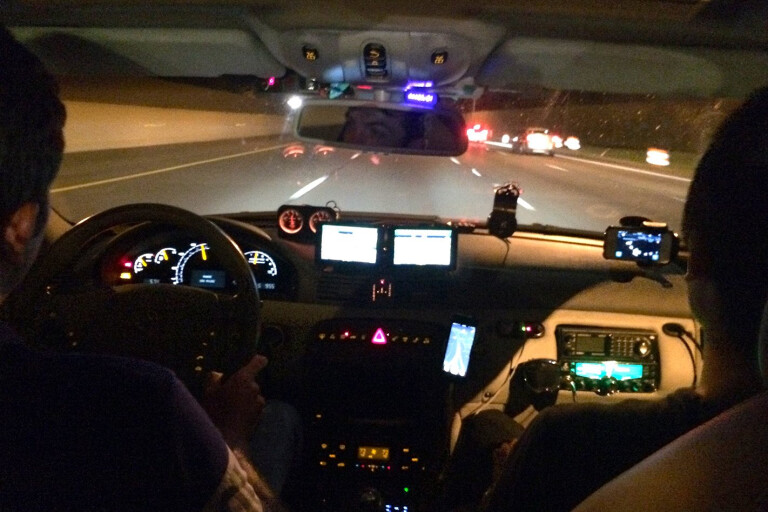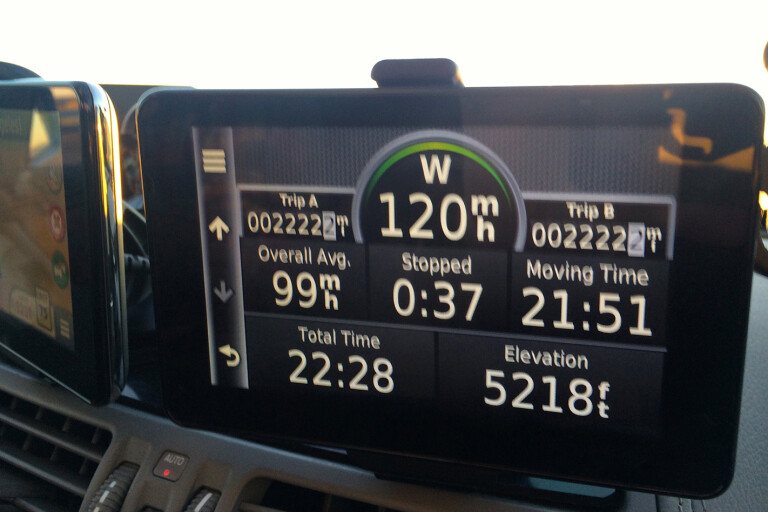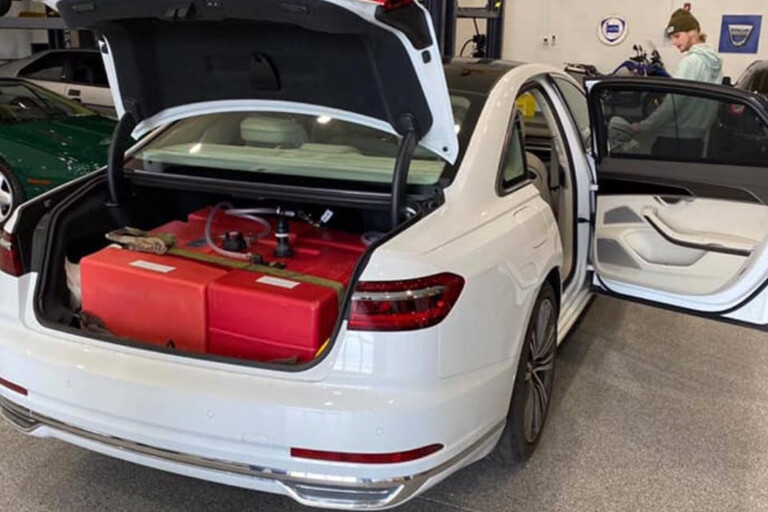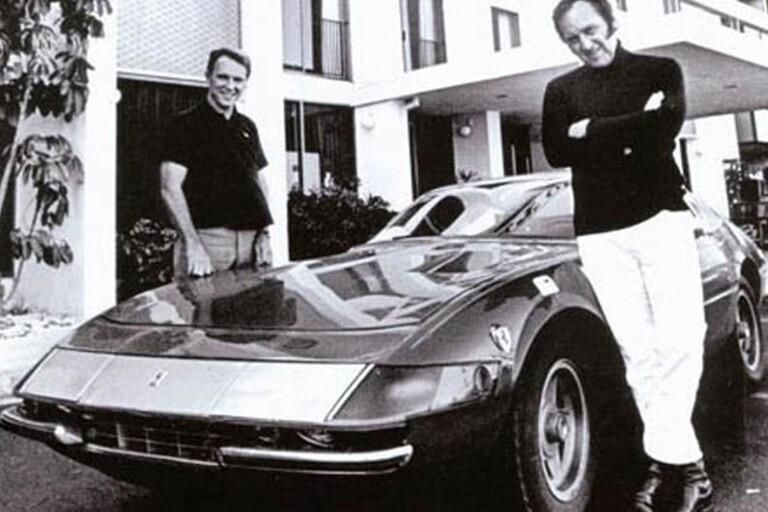
This article first appeared in the March, 2014 issue of Wheels magazine. Since then the Cannonball Run record has been lowered to below 26 hours, and Ed Bolian has become a pseudo-adjudicator of record attempts.
Meet Ed. He’s a tall, slow-speaking 27-year-old from Atlanta who used to breed albino lizards, teaches Sunday School with his wife and makes a living selling Lamborghinis.
Oh, and Ed Bolian is also the quickest man in America.
Yep, this gangly, goofy-looking used-car salesman is the fastest man on four wheels across the States, a title he earned after driving the breadth of the country – some 4527km – in a record-shattering, eyeball-searing, police-dodging 28 hours and 50 minutes.

Above: Bolian and co-driver Dave Black.
It’s an effort that’s made him a superstar in the underground world of outlaw cross-country road racing – think Dom Toretto without the muscles – but we’ll forgive you if you’ve never heard of Ed.
In Australia, the world of American transcontinental racing is largely unknown, but to the Yanks, racing from New York to Los Angeles, or chasing the sun from the Atlantic to the Pacific, is big news. It’s their version of the Redex Trial, with American gearheads pointing modified GT cars from one city to another since the 1930s.
But before we get into the who, how and why of Ed’s record, one needs to appreciate the magnitude of his achievement. If he’s to be believed, he didn’t just break the old transcontinental yardstick of 31hr, 4min set in 2006, he shattered it by a staggering two hours and 14 minutes. Putting that into perspective, Google Maps says the journey should take 40 hours.
And the best thing? Ed didn’t write himself into the history books by piloting a state-of-the-art supercar. Instead, he, his co-driver Dave Black and navigator Dan Huang, strapped themselves to a 2004 Mercedes-Benz CL55 AMG that they picked up for 18 grand.
So how’d he do it? How did Ed and his team average 158km/h, stay awake for 30 hours and, more importantly, avoid getting pinched by the cops and thrown into jail? Or worse, crash?
It dates to Ed’s formative years.
“I’ve wanted to do this trip since I was in high school,” he told Wheels. “I just thought it’d be an awesome thing but then I found out people have been doing it for decades. So, after thinking about it for years, it wasn’t until about 18 months ago I decided it was time to knuckle down and really go for it.”

Above: The GPS used by Bolian on his record run
But one doesn’t simply ‘decide’ to race 4500km at 255km/h and expect to live or avoid jail time. Preparation was needed, with the most crucial decision being the choice of car.
“We looked at everything, and I mean everything,” Ed explained. “I wanted to do it in something more exotic because I figured it’d be a car that I’d be tied to for a very long time. We talked about Lamborghinis and Ferraris – a Bentley would have been perfect. But none of these could carry the amount of fuel we needed.”
And don’t think Ed is being self-indulgent here with all this talk of supercars. He has a long history with expensive metal, having started his own supercar hire company during college, “before the economy got bad and a 20-year-old kid without any proof of income could get a loan for a Lamborghini”. His personal cars have included “a few Ferraris and Gallardos and a couple of Porsches. Right now I’ve got a Lamborghini Murcielago LP640 roadster.”
Impressive, sure, but despite his penchant for the rare and expensive, Ed says the CL55 made the most sense.
“It was built to go fast for a very long time, it has lots of cooling, it’s supercharged so it makes lots of power and they’re generally reliable,” he said. “It also has active suspension, which we needed to level out the fuel tanks.”
Yes, fuel tanks – plural. To get his desired fuel range of 1335km, Ed bolted two 83-litre tanks into the CL’s boot, giving it a total capacity of 253 litres. That meant the whole trip could be completed with just three fuel stops. The additional tanks were even able to be fuelled simultaneously, to save time. But cramming all that fuel into the CL has its drawbacks.
“It smelt pretty bad,” Ed laughed. “The car still had all its fire protection so we felt pretty safe and I don’t think there’s much of a flame risk, but it stinks pretty bad. The fumes would accumulate when we were stationary, so it wasn’t bad during the trip, but since then it’s become insufferable.”
.jpg )
Above: This modified Mercedes-AMG E63 was used to break the Cannonball Run record in 2019.
So what about cost? Well despite initial protestations that he “tried not to keep count,” Ed reckons he dropped US$15,000-20,000 on parts and modifications, on top of the CL55’s 18-grand purchase price.
“It was quite expensive,” he admitted. Given he was considering Ferraris and Lamborghinis, it could have been much worse.
With the car sorted – “Of course we gave it a major service and replaced every fluid, every filter, sparkplugs, wires, suspension and fuses” – Ed turned his attention to the next biggest hurdle: the police.
“This trip wasn’t about saying that police are inadequate or speed limits should be abolished or anything like that,” Ed stressed. “We just wanted to do something interesting and, like the fuel range, reliability and navigation, policing was simply another variable to contend with.”
To combat the cops, the CL was fitted with every “countermeasure protection” Ed could get his hands on. Radar detectors, laser jammers and police scanners on the dash. Even a pair of binoculars. They also roped in friends to act as sweep cars in several states, driving at the speed limit 150-200km ahead to warn of traffic issues or cops.
“And honestly we only had one close call,” Ed said. “We passed one cop in Ohio and he wasn’t shooting radar or using laser so none our of systems picked him up. I wasn’t driving at the time and screamed: ‘Brakes! Brakes! Brakes!’ We did slow down from about 210km/h to 150km/h but we still passed him going way too fast. He just didn’t seem to notice.”
Several state-of-the-art navigation systems took care of the route and avoided traffic while also electronically logging the car’s progress – crucial data when it comes to proving the record – but there was one delicate issue Ed was yet to tackle: number twos.
“We had some onboard facilities – urine bottles and bedpans – but they went out the window pretty quick,” he laughed. “We decided it wasn’t worth the indecency; we went when we stopped for gas.”

Above: Arne Toman and Doug Tabbut performed an extremely well-prepared Cannonball Run in 2019, lowering the record to 27 hours and 25 minutes.
So with the essentials sorted, all that remained was to point the car at the horizon and pin the throttle. With no official start line, Ed’s team decided to follow the original Cannonball route and set off from Manhattan at 9:56pm. Astonishingly, despite the distances, the speeds and the fatigue, Ed says the actual trip was the easiest part of the whole record attempt.
“The preparation was the hardest for sure. The trip itself was really good and even though we’d heard of people hallucinating on previous attempts we didn’t encounter any of that. We wanted to be able to sleep, but I probably only got a bit less than an hour for the whole trip. You can never predict what the adrenalin will do to your body and we didn’t even use a lot of energy drinks or stimulants. We were going so fast and staying so plugged in it was like a natural high. When we got into LA at 11:46pm we were still so pumped we didn’t even go to bed. We went to an all-night breakfast diner and had some food.”
Despite his bravado, Ed admits there were a few nervous moments, like blasting past that Ohio cop at go-directly-to-jail speed and one near-death experience where two of the CL’s wheels left the road at 210km/h.
“A truck I was coming up on tried really late to pass another truck,” Ed explains, “so he didn’t see me coming and basically merged on top of me. Somehow I managed to regain control.”
And then there were the speeds. Ed left the CL55’s speed limiter intact (the trade-off of speed against fuel economy wasn’t worth it) so top speed was 246km/h, with the average number for the whole trip being just shy of 160km/h. When you take out 46 minutes of stationary refuelling time, that means most of the driving was spent on the far side of 200km/h.
So, what about speeding tickets? Ed is yet to receive any in the mail and remains reluctant to publish his GPS data for fear of being fined after the fact, but says without any hard evidence it’s virtually impossible for the cops to cuff him.
“In reality, claiming we averaged 100mph over all these states doesn’t say where we actually sped, so it’s very difficult for the police to say with any confidence that I was speeding at a specific point or who was actually driving.”
So what now? Has shattering one record sparked an insatiable thirst for more? Or is Ed content to simply retire with his stinky CL55 and regale his grandchildren with tales of his, umm, achievement?
“I’ve never really been one to hold on to cars or things for very long but it’s going to be very hard to get rid of this one, so I think I’ll probably have to keep it forever and show the grandkids.
“You know, we’ve talked about other records and other benchmarks that are out there like the Pan America Highway, going from Alaska to the southern tip of South America. There’s been some talk of a record from London to Cape Town, Beijing to Paris, or even a lap of Australia but nothing has stood out. Yet.”

Above: This lightly-modified Audi A8 performed a 26 hour and 38 minute run at the start of the COVID-19 pandemic in 2020.
The wild numbers of Ed Bolian’s record run
- 4527km: distance covered
- 158km/h: Ed’s average speed
- 246km/h: Top speed of Ed’s C55 AMG
- 2 hours 14 minutes: How much Ed slashed off the existing record
- 40.5 hours: How long Google Maps says the trip should take
- 46 minutes: Amount of time Ed’s Merc was stationary
- 1: near accident
- 1: police scare

History of the Cannonball Run record
Never heard of American transcontinental racing? Well it’s nothing new – Yankee gearheads have been racing from New York to LA since 1933.
Edwin ‘Cannonball’ Baker set the original benchmark, in a car called Blue Streak, at 53 hours 30 minutes – a record that stood for 40 years.
In Ed’s honour, Car & Driver journalist Brock Yates established the Cannonball Run in the 1970s to protest highway speed limits, with the record steadily improved until 1979 when Dave Heinz and Dave Yarborough made the trip in 32 hours 51 minutes in a Jaguar XJS.
That mark was beaten again in 1983 by Doug Turner and David Diem who raced a Ferrari 308 across the States in 32 hours 7 minutes – a yardstick that lasted more than 20 years.
Alex Roy and Dave Maher bettered it again in 2006 with a time of 31 hours 4 minutes in a BMW M5.
And then Ed arrived.



COMMENTS